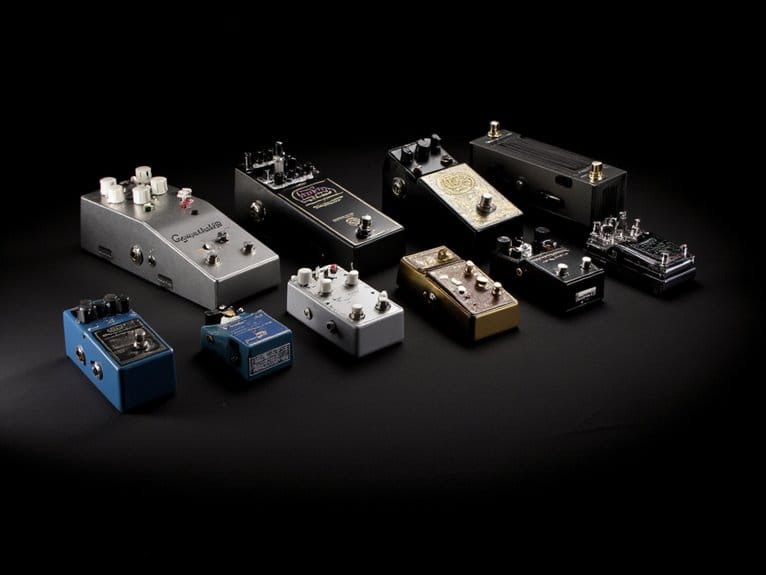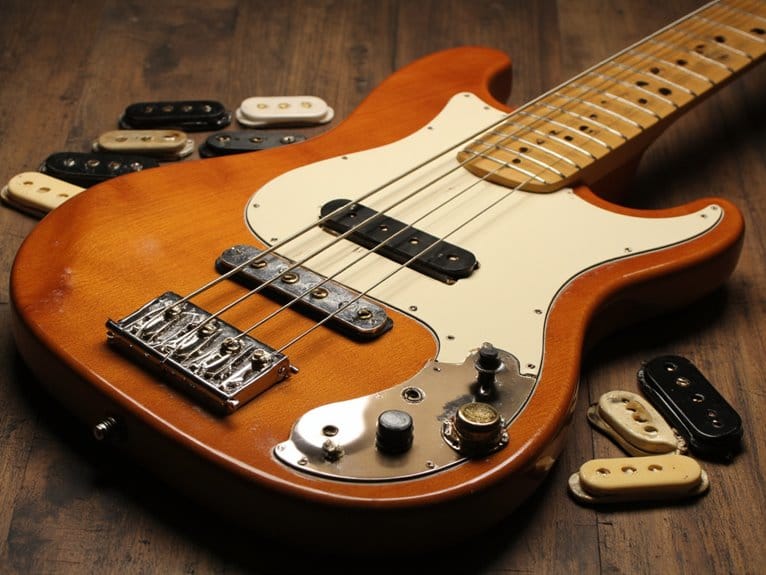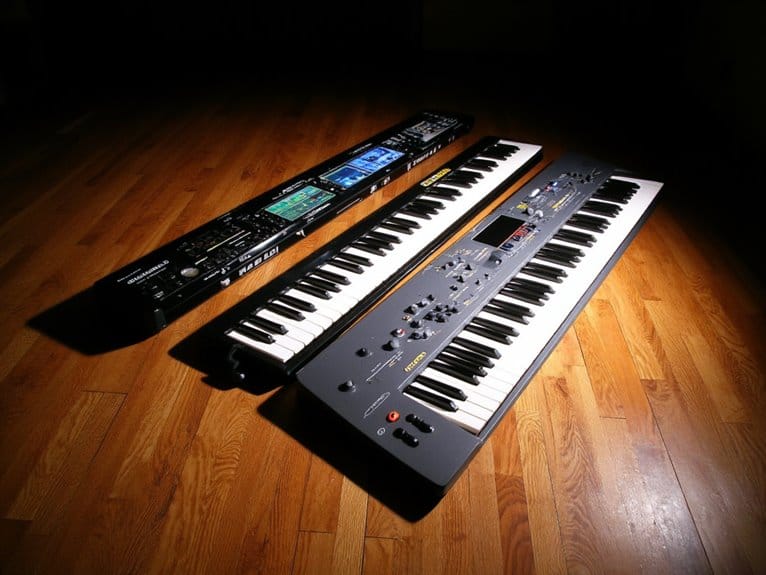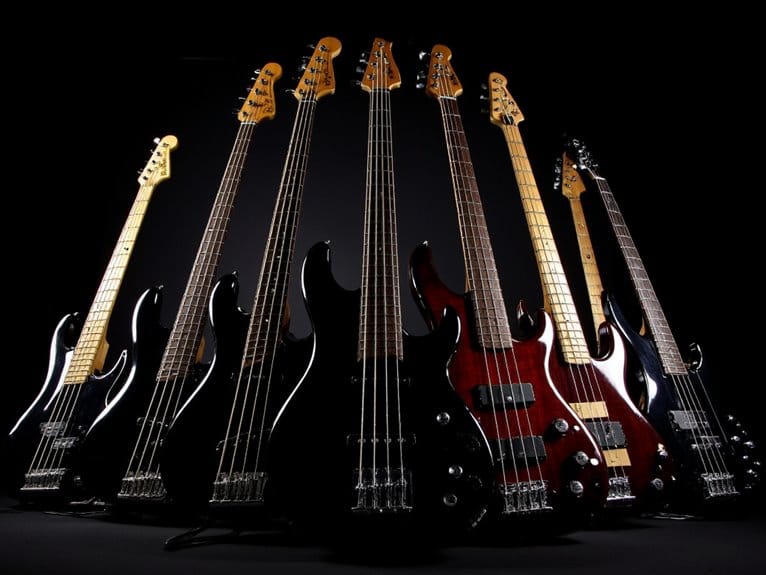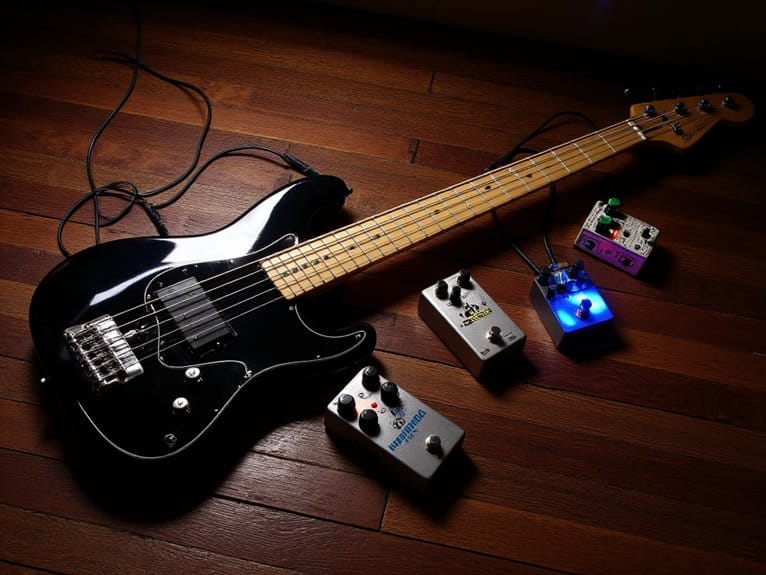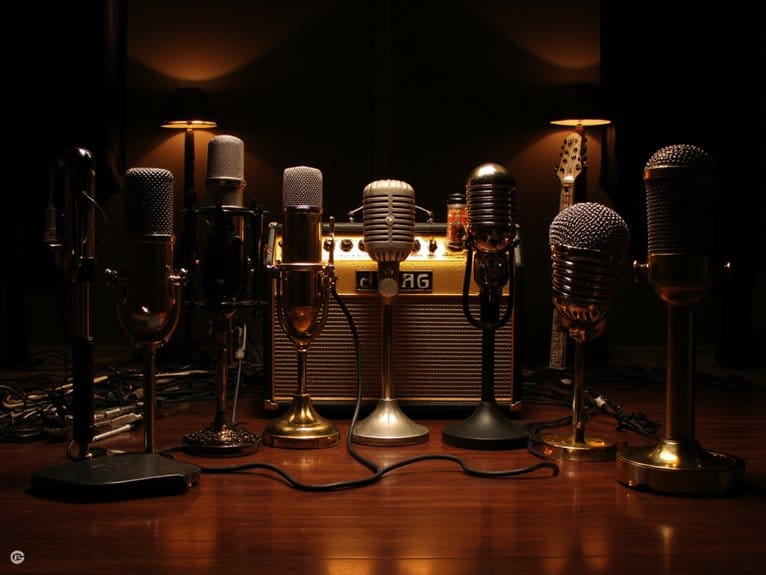10 Best Bass Preamp Pedals – Reviews & Top Picks
I’ve tested dozens of bass preamp pedals, and my top picks for 2025 include the MXR Bass D.I.+ for its dual-channel versatility and 4.6-star rating, the Tech 21 SansAmp Bass Driver DI V2 for studio-quality tone shaping, and the budget-friendly JOYO TIDAL WAVE R-30 with extensive EQ controls. The JIM DUNLOP MXR M81 excels for passive basses, while SONICAKE’s B Factory combines analog warmth with digital flexibility. Below, I’ll break down each pedal’s strengths to help you find your perfect match.
We are supported by our audience. When you purchase through links on our site, we may earn an affiliate commission, at no extra cost for you. Learn more.
Notable Insights
- MXR Bass Preamp M81 offers compact design with versatile 3-band EQ, earning 4.6 stars for improving passive bass clarity.
- Tech 21 SansAmp Bass Driver DI V2 provides studio-quality tone shaping with reliable DI capabilities and parallel output design.
- JOYO TIDAL WAVE R-30 delivers budget-friendly analog warmth under $100 with comprehensive EQ and CAB emulation for recording.
- MXR Bass D.I.+ features dual-channel preamp with clean and distortion modes, plus built-in noise gate for versatile performance.
- JHS Colour Box V2 Preamp stands out with five gain stages and precision EQ, achieving 4.8/5 stars from users.
JIM DUNLOP Power Amplifier (11081000001)
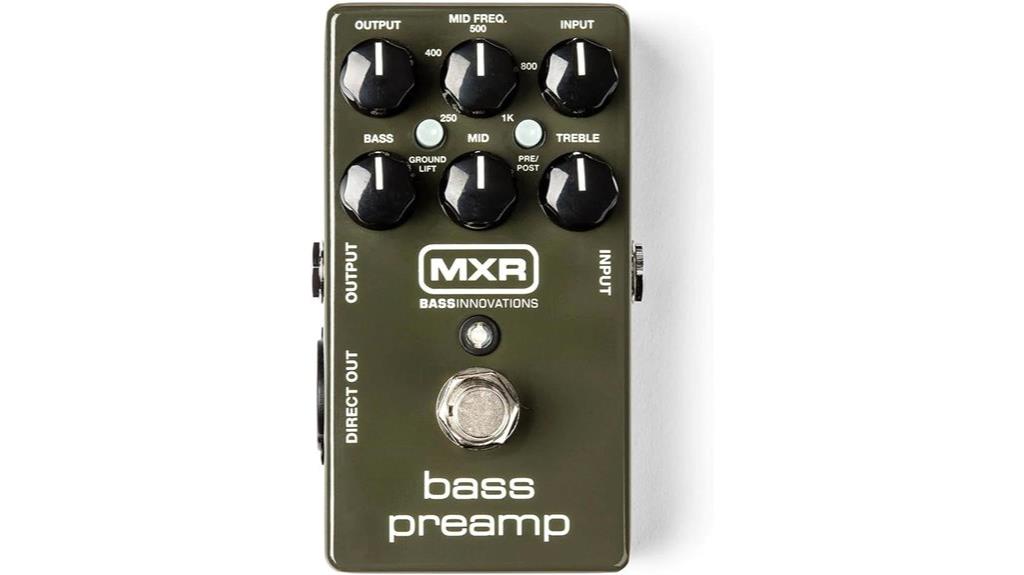
When you’re searching for a bass preamp that delivers professional-grade tone shaping without commandeering your entire pedalboard, the JIM DUNLOP Power Amplifier (model 11081000001), better known as the MXR Bass Preamp M81, stands as a compelling choice for bassists who prioritize versatility and studio-quality output. Measuring just 5.5 x 2.5 x 4.5 inches and weighing 8 ounces, this compact unit won’t strain your back or pedalboard real estate. You’ll appreciate the separate input and output level controls alongside a 3-band EQ featuring sweepable midrange, which proves particularly effective with passive basses and vintage pickups like mudbuckers. While the learning curve around internal dip switches can be frustrating—thanks to the sparse manual—the 4.6-star rating from 170 users suggests most bassists find the tonal improvements worth the initial setup challenges.
Best For: Bassists seeking professional-grade tone shaping in a compact format, particularly those using passive basses or vintage pickups who need studio-quality direct output for live performances and recording.
Pros:
- Compact design (5.5 x 2.5 x 4.5 inches, 8 oz) saves pedalboard space while delivering professional tone enhancement
- Versatile 3-band EQ with sweepable midrange and studio-quality direct output works effectively with various bass types
- High user satisfaction with 4.6/5 star rating, particularly praised for improving sound clarity and live performance capabilities
Cons:
- Learning curve for internal dip switch settings due to inadequate manual documentation
- Excessively bright LED can be distracting during performances
- Effectiveness depends on existing pickup quality rather than fixing inherently poor bass tone
JOYO Bass Guitar Preamp Overdrive Pedal (TIDAL WAVE R-30)
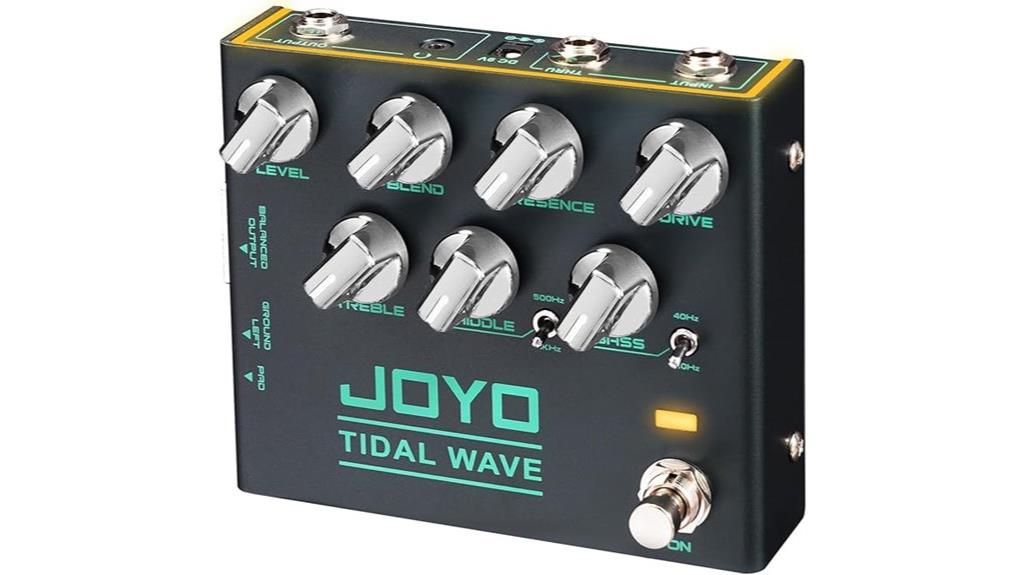
Budget-conscious bassists seeking professional-grade tone without breaking the bank will find their sweet spot with the JOYO Bass Guitar Preamp Overdrive Pedal (TIDAL WAVE R-30), a feature-packed analog powerhouse that punches well above its sub-$100 price point. You’ll appreciate the responsive 3-band EQ system with switchable frequency options—middle frequencies at 500/1000Hz and bass frequencies at 40/80Hz—alongside Level, Blend, Presence, and Drive controls that deliver everything from subtle warmth to aggressive stoner fuzz. The DI output with CAB emulation makes studio recording straightforward, while the innovative R Series LED lighting adds visual flair during live performances.
Best For: Budget-conscious bassists who want professional-grade tone versatility for pop, funk, and metal genres without spending on expensive pedals.
Pros:
- Comprehensive 3-band EQ with switchable frequencies (500/1000Hz mid, 40/80Hz bass) and multiple control knobs for extensive sound customization
- DI output with CAB emulation for direct studio recording and noise reduction features including Ground Left switch
- Exceptional value at under $100 with durable metal alloy construction and innovative LED lighting for live performances
Cons:
- Mixed user feedback regarding octave functionality when using fuzz effects
- Requires separate 9V DC power supply (JOYO brand recommended for optimal performance)
- Relatively new product (available since November 2023) with limited long-term reliability data
MXR Bass D.I.+
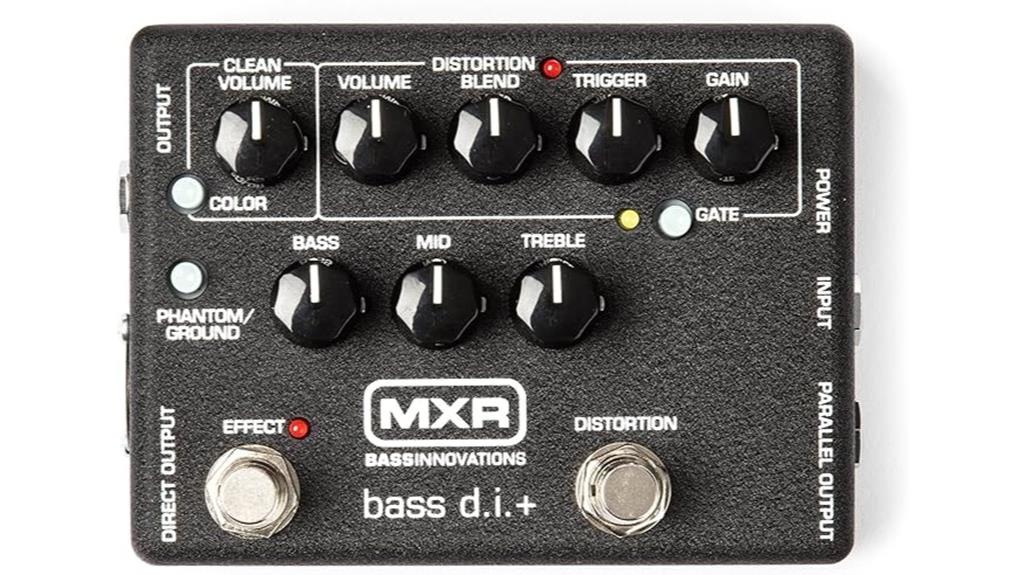
The MXR Bass D.I.+ (Model M80) stands as the quintessential Swiss Army knife for bassists who demand both pristine clean tones and aggressive distortion without carrying multiple pedals to every gig. You’ll find its dual-channel preamp delivers exceptional versatility, featuring an extensive 3-band EQ, Color knob for tonal shaping, and adjustable gain, volume, and blend controls that rival more expensive alternatives. The built-in noise gate guarantees silent operation between notes, while multiple outputs accommodate multi-amp, PA, and studio setups seamlessly. At 4.6 stars from 323 reviews, this compact 8-ounce powerhouse effectively handles both active and passive basses across genres.
Best For: Bassists who need a versatile, all-in-one solution for both clean and distorted tones across multiple performance settings without the hassle of carrying numerous pedals.
Pros:
- Dual-channel preamp with comprehensive controls including 3-band EQ, Color knob, and built-in noise gate for silent operation
- Multiple outputs accommodate various setups from live performances to studio recordings with multi-amp configurations
- Excellent value at a lower price point compared to competitors while offering similar features and working effectively with both active and passive basses
Cons:
- Single 9V battery power source may require frequent battery changes during extensive use
- Limited to basic distortion effects compared to dedicated multi-effects units
- Compact size may make precise control adjustments challenging during live performances
SONICAKE Bass Pedal with Overdrive Analog Preamp (B Factory)
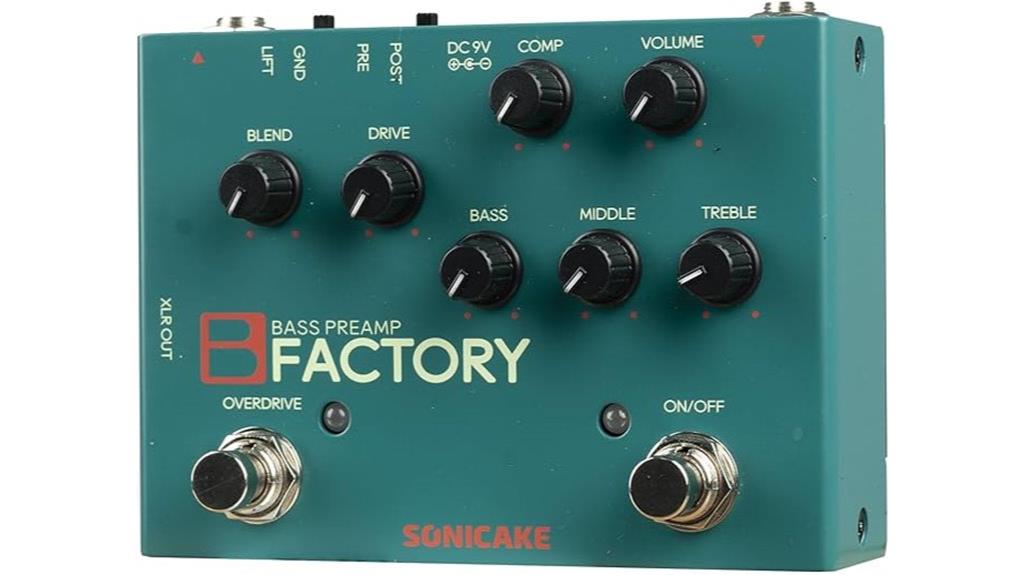
SONICAKE’s B Factory stands out as the ideal choice for bassists who need extensive tone shaping without breaking the bank, combining analog warmth with modern versatility in a compact package. You’ll appreciate the thoughtful combination of optical compression and overdrive capabilities, which work together seamlessly with the 3-band EQ to deliver professional-grade sound enhancement. The PRE/POST selection gives you precise control over your signal chain, while the high impedance input and XLR balanced output guarantee compatibility with virtually any setup. The specially designed Buffer Bypass Circuit maintains your tone’s integrity even when the pedal’s disengaged, though you’ll need to source your own 9V power supply.
Best For: Bassists seeking professional-grade tone shaping and sound enhancement with analog warmth, optical compression, and overdrive capabilities in an affordable, compact pedal.
Pros:
- Combines multiple essential bass effects (analog preamp, optical compression, overdrive, and 3-band EQ) in one compact unit
- Versatile connectivity options with high impedance input and XLR balanced output for professional setups
- Buffer Bypass Circuit maintains pristine tone quality even when the pedal is disengaged
Cons:
- Power supply not included, requiring separate purchase of 9V center negative adapter
- May have a learning curve for beginners due to multiple tone-shaping controls and options
- Compact size may make precise adjustments challenging during live performances
Tech 21 SansAmp Bass Driver DI V2
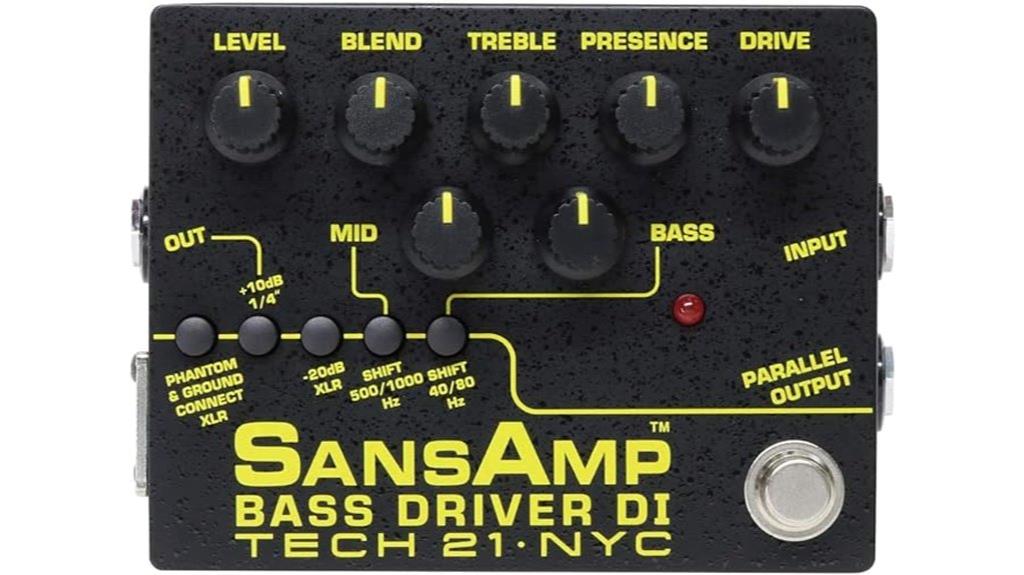
Professional bassists who demand studio-quality tone shaping and reliable DI capabilities will find their match in the Tech 21 SansAmp Bass Driver DI V2, a pedal that’s earned its stripes through decades of live performance and recording session use. You’ll appreciate the selectable midrange frequency control that accommodates various pickup types, while the extended bass control lets you dial in center frequencies at either 80Hz or 40Hz for precise low-end management. The parallel output design, combined with both XLR and 1/4-inch outputs, gives you the flexibility to run direct to your PA system while simultaneously feeding your amp head for stage monitoring, eliminating the need to haul heavy gear to every gig.
Best For: Professional bassists and serious players who need studio-quality tone shaping, reliable DI capabilities for live performances, and the flexibility to run direct to PA systems while maintaining stage monitoring through their amp.
Pros:
- Selectable midrange frequency control and extended bass control (80Hz or 40Hz) provide precise tone shaping for different pickup types and musical styles
- Parallel output design with both XLR and 1/4-inch outputs allows simultaneous connection to PA and amp for versatile live setup options
- Proven reliability with decades of professional use in studios and live performances, earning a 4.7/5 star rating from 372 users
Cons:
- Plastic construction may feel less premium compared to metal-bodied alternatives in the same price range
- Requires 9V battery power (though phantom power is available), adding ongoing operational costs
- Limited to bass-specific applications, making it a specialized tool rather than a versatile multi-instrument preamp
Zoom MS-60B+ MultiStomp Bass Effects Pedal with 95+ Effects
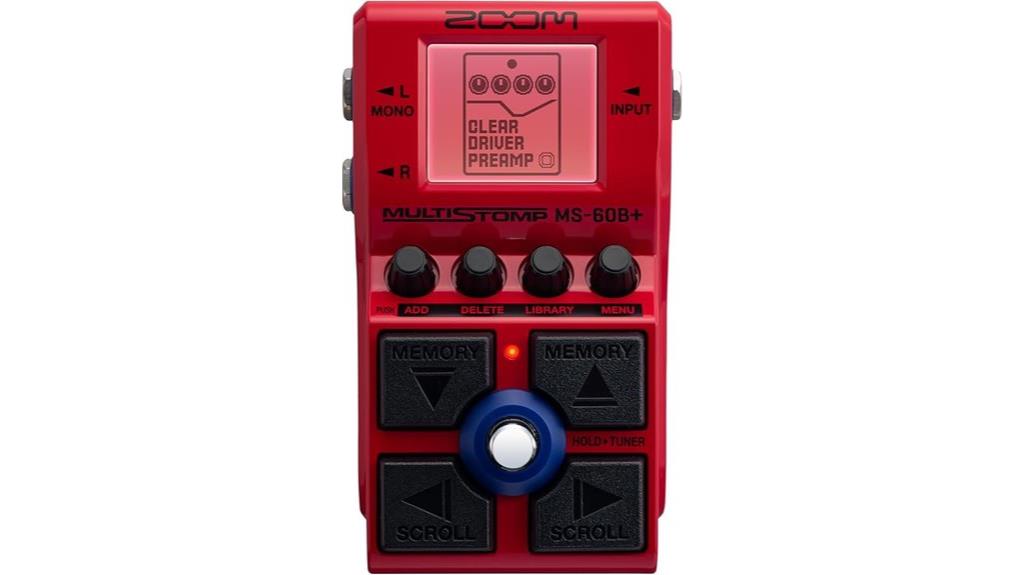
Budget-conscious bassists who crave maximum versatility will find their perfect match in the Zoom MS-60B+ MultiStomp, a compact powerhouse that delivers over 95 effects, 11 amp models, and 11 preamp recreations in a single pedal that weighs just 15.7 ounces. You’ll appreciate the ability to chain up to six effects simultaneously, transforming this 5.8 x 3.4 x 2.75-inch unit into an entire effects arsenal that fits comfortably on any pedalboard. While the effects won’t match studio-grade processors, they’re impressively versatile for the price point, offering everything from filters and drives to synths and reverbs that’ll keep you experimenting for hours.
Best For: Budget-conscious bass players and hobbyist musicians seeking maximum effects versatility in a compact, affordable pedal that offers extensive sound experimentation without breaking the bank.
Pros:
- Exceptional value with 95+ effects, 11 amp models, and 11 preamp recreations in one compact 15.7-ounce unit
- Ability to chain up to 6 effects simultaneously with user-friendly interface and easy learning curve
- Versatile connectivity options including USB-C for file management and power, plus battery operation for portability
Cons:
- Effects quality doesn’t match studio-grade processors, limiting professional recording applications
- Limited to bass-focused effects processing, reducing versatility for other instruments
- Compact size may make navigation and parameter adjustment challenging during live performance
Laney Digbeth DB Bass Guitar Pre Amplifier Pedal, Black
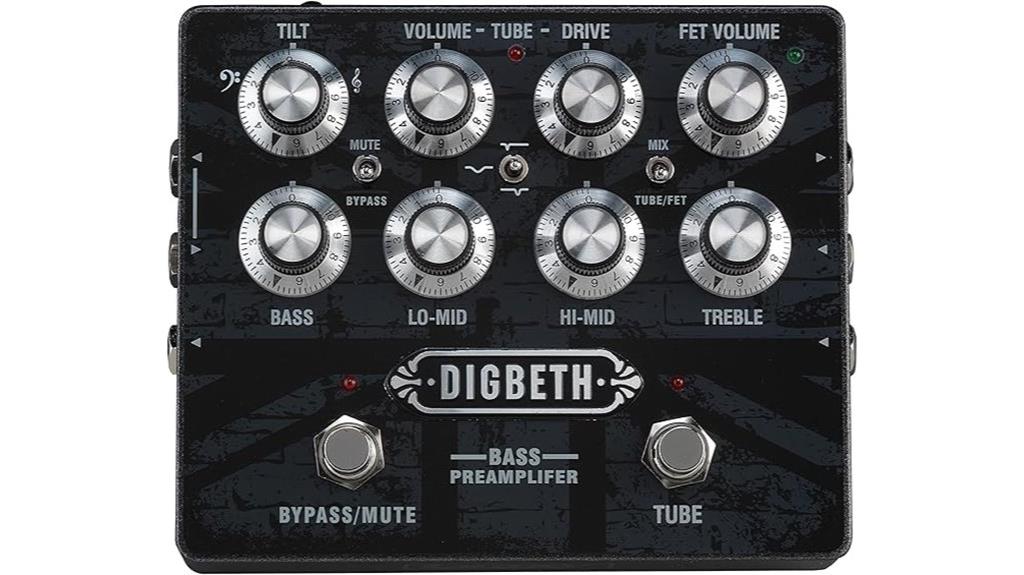
Versatility becomes the defining characteristic when I examine the Laney Digbeth DB Bass Guitar Pre Amplifier Pedal, a dual-channel powerhouse that excels for bassists who refuse to be locked into a single sonic signature. You’ll appreciate the FET and tube signal paths with blend switch, allowing seamless shifts between crisp solid-state clarity and warm tube saturation. The three-band EQ features switchable low-mid frequencies for precise tonal sculpting, while the DI output offers pre/post source selection for recording flexibility. At 4.4 stars from twenty-six reviews, users consistently praise its tonal improvement capabilities with existing combo amps, though some request active/passive input switching instead of separate inputs.
Best For: Bass players seeking versatile tonal control and sound enhancement for their existing rigs, whether using active or passive basses in studio recording or live performance settings.
Pros:
- Dual signal paths (FET and tube) with blend switch provide exceptional versatility from crisp solid-state to warm tube tones
- Three-band EQ with switchable low-mid frequencies and DI output with pre/post selection offer precise tonal sculpting and recording flexibility
- Strong 4.4-star rating with consistent user praise for significant tonal improvements when paired with combo amps
Cons:
- Uses separate active/passive inputs instead of a more convenient active/passive input switch that some users prefer
- Limited to 20 watts output power which may not suit all performance requirements
- Relatively new product (available since 2021) with only 26 reviews providing limited long-term reliability data
POCKET AMP BASS Portable Bass Preamp (PEPAMPBASS)
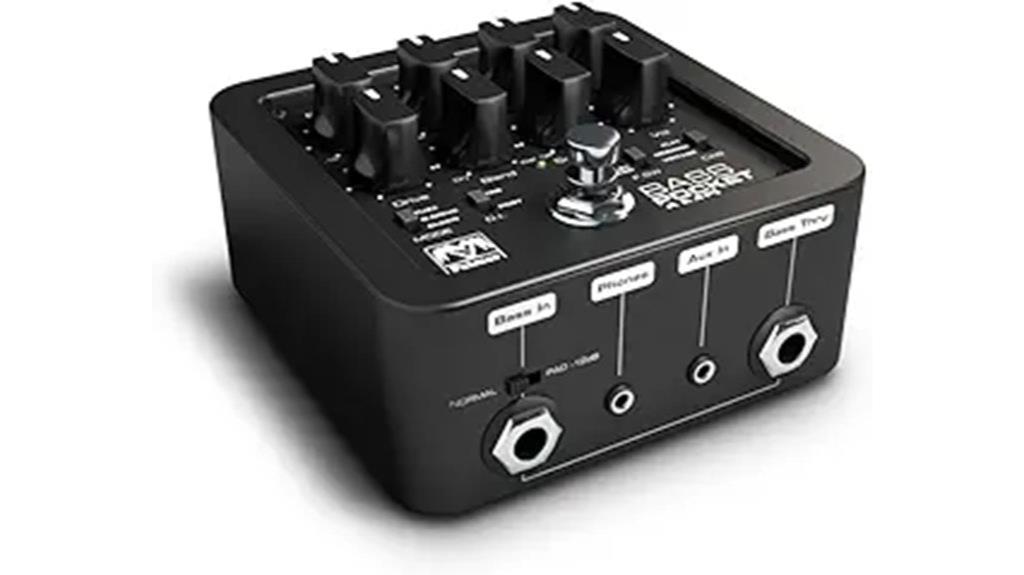
German engineering meets portable convenience in the POCKET AMP BASS Portable Bass Preamp, a compact powerhouse that’s earned the top spot in Amazon’s Bass Guitar Amplifier Preamps category for good reason. You’ll appreciate the extensive sound shaping capabilities, featuring clean, overdrive, and fuzz modes with adjustable drive and saturation controls that work equally well with active and passive bass guitars. The 3-band EQ includes a semi-parametric mid control specifically designed for bass frequencies, while vintage or modern cabinet simulation adds professional polish to your tone. At 14.1 ounces and measuring just 2.3 x 5 x 1.3 inches, it fits easily in your gig bag.
Best For: Bass players who need a versatile, portable preamp solution for gigging, recording, and practice sessions with extensive tone shaping capabilities and direct PA connectivity.
Pros:
- Comprehensive sound control with clean/overdrive/fuzz modes, 3-band EQ with semi-parametric mid control, and cabinet simulation specifically designed for bass guitars
- Ultra-portable design at 14.1 ounces with 25-hour battery life, built-in DI box, and aux/headphone inputs for maximum versatility
- Top-rated performance with 4.4/5 stars from 170 reviews and #1 ranking in Bass Guitar Amplifier Preamps category
Cons:
- Power adapter sold separately for AC operation, adding to total cost and setup requirements
- Some users report issues with effect switching during live performances and occasional noise in certain settings
- Requires TRS cable for effects loop functionality, which may not be included with standard bass setups
JOYO Bass Overdrive Pedal with DI & XLR Output (D53)
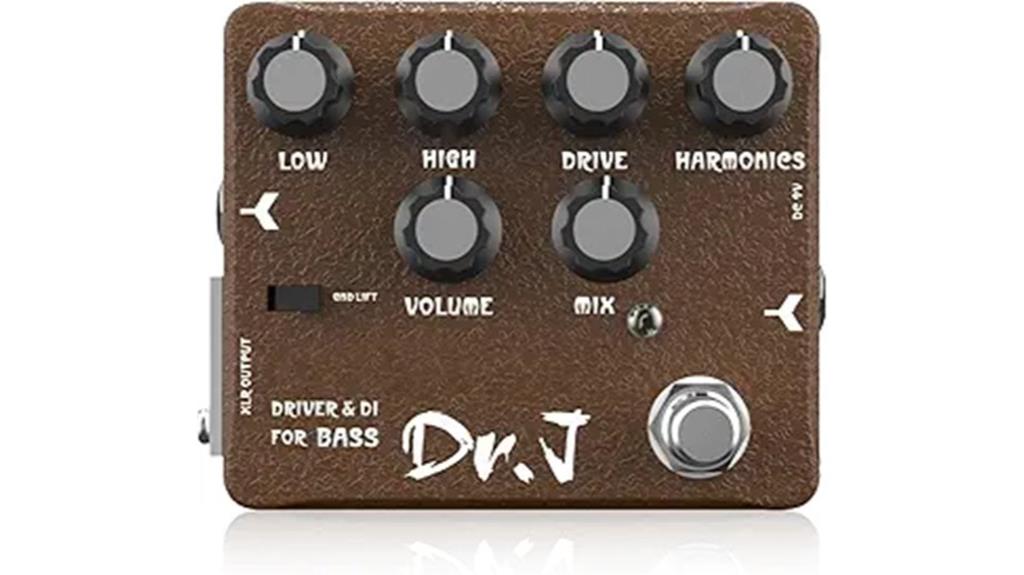
Why would bassists seeking professional recording capabilities choose the JOYO Bass Overdrive Pedal with DI & XLR Output (D53) over more expensive alternatives? This micd tube bass amp simulator delivers analog cabinet emulation circuitry that captures classic tube warmth, while its built-in XLR DI output handles both live performances and studio recording sessions without requiring additional gear. You’ll find the Drive, High, Low, HF Harmonics, and Mix controls provide extensive tonal shaping, allowing you to blend fuzz textures with clean signals while preserving your low-end foundation. Though some users report toggle switch popping issues, the pedal’s #2 ranking in bass overdrive effects, combined with its 4.3-star rating from 163 reviews, demonstrates its competitive performance against boutique options at a fraction of the cost.
Best For: Bassists who need professional recording and live performance capabilities with tube amp simulation and DI output functionality at a budget-friendly price point.
Pros:
- Built-in XLR DI output eliminates need for additional gear during recording sessions and live performances
- Extensive tonal control with Drive, High, Low, HF Harmonics, and Mix knobs for versatile sound shaping
- Delivers analog cabinet emulation and classic tube warmth at a fraction of boutique pedal costs
Cons:
- Some users experience loud popping issues with the toggle switch during operation
- DI function may have compatibility concerns with specific setups and power adapters
- Limited documentation available for optimal usage and setup guidance
Factors to Consider When Choosing a Bass Preamp Pedal
When I’m helping bassists choose the right preamp pedal, I focus on five critical factors that’ll determine whether you’re getting a tool that enhances your sound or just another expensive paperweight taking up valuable pedalboard real estate. Your sound quality requirements and EQ preferences should drive the decision first, since there’s no point in having pristine direct out capabilities if the pedal can’t deliver the tonal character you need for your musical style. I always recommend considering power source compatibility and physical dimensions early in the selection process, because even the most sonically perfect preamp becomes useless if it doesn’t integrate seamlessly with your existing setup and performance requirements.
Sound Quality Requirements
Sound quality stands as the cornerstone of any worthwhile bass preamp pedal, and I’ve found that understanding the technical elements behind great tone can make the difference between a mediocre purchase and a game-changing addition to your rig. Analog circuitry typically delivers warmer, more musical tones compared to digital alternatives, though I’ll admit the gap has narrowed considerably in recent years. A quality 3-band EQ becomes essential for shaping bass frequencies across different musical styles, while blend and drive controls add character without sacrificing clarity. Dual XLR and 1/4″ outputs provide vital flexibility for both live and studio applications, ensuring your sound maintains integrity regardless of setup. I consistently notice improved clarity and versatility when using bass-specific preamps, particularly with passive instruments.
EQ and Tonal Controls
EQ and tonal controls represent the creative heart of any bass preamp pedal, transforming your instrument’s raw signal into precisely the sound you hear in your head. I’ve found that most quality preamps feature a 3-band EQ configuration, giving you independent control over bass, mid, and treble frequencies for thorough sound shaping. The real game-changer, though, comes with sweepable midrange controls that let you pinpoint specific frequencies instead of being stuck with fixed ranges. Advanced models often include presence knobs or hi-pass switches, which I’ll admit seemed unnecessary until I started using them regularly. Remember that your pickup type and amplifier characteristics will greatly influence how effectively these EQ settings translate into your final sound.
Direct Out Capabilities
Connectivity becomes your secret weapon when you’re dealing with direct out capabilities, and I’ve learned that a quality XLR output can make or break your live performance or recording session. I’ve found that pedals offering pre/post EQ selection give you tremendous flexibility, letting you decide whether your carefully crafted tone reaches the mixing console or stays with your stage amp. The built-in DI functionality eliminates extra gear clutter, which honestly makes my setup process much smoother during those rushed soundchecks. What really matters, though, is the internal circuitry quality—I’ve noticed that cheaper components can introduce noise or signal degradation that’ll haunt your recordings later, so investing in pedals with robust direct output sections pays dividends.
Power Source Options
Power management might not sound like the most exciting aspect of choosing a bass preamp pedal, but I’ve learned the hard way that ignoring this factor can lead to some pretty embarrassing moments on stage. Most bass preamps operate on standard 9V DC power, either through wall adapters or batteries, which gives you flexibility for different performance situations. I always check power consumption specifications since higher-wattage pedals can drain batteries faster than you’d expect during long gigs. Some models offer phantom power compatibility, which is incredibly useful when working with professional recording equipment or complex pedalboard setups. Understanding your pedal’s power requirements, including adapter specifications and battery life expectations, helps prevent those awkward mid-song power failures that nobody wants to experience.
Pedalboard Space Considerations
Real estate on your pedalboard becomes precious quickly, and I’ve discovered that choosing the right bass preamp means balancing functionality with the physical footprint you’re willing to sacrifice. Compact models measuring around 5.5 x 2.5 x 4.5 inches offer excellent space efficiency, while lighter pedals around 8 ounces make transport notably easier during those inevitable late-night gig teardowns. I’ve found that multi-functional designs combining distortion, EQ, and DI output capabilities reduce the need for additional pedals, maximizing your board’s real estate. Streamlined interfaces with fewer knobs allow quicker adjustments and consume less space, though I’ll admit that sometimes fewer controls mean sacrificing some tonal flexibility for convenience.
Budget and Value
Three price tiers dominate the bass preamp pedal market, and I’ve learned that understanding where each fits your needs prevents both overspending and the frustration of buying twice. Budget-conscious models between $50-$100 offer solid performance, with many customer favorites earning 4.5+ star ratings that prove you don’t need premium pricing for quality tone shaping. I’ve found that pedals under $100 often include essential features like DI outputs and multi-band EQ controls, delivering surprising value for gigging musicians. High-end options exceeding $200 provide advanced functionality, but honestly, most players find excellent performance in the middle tier. When evaluating options, I prioritize multi-functional designs with solid warranties, since these features enhance long-term value and provide confidence in your investment.
On a final note
After testing these eight exceptional bass preamps, I’ve found each offers distinct advantages for different playing styles and budgets. Whether you’re seeking the legendary warmth of the Tech 21 SansAmp, the versatile overdrive capabilities of JOYO’s offerings, or MXR’s reliable DI functionality, there’s something here for every bassist. I’d recommend considering your primary needs—live performance, studio recording, or practice—before making your final decision.

